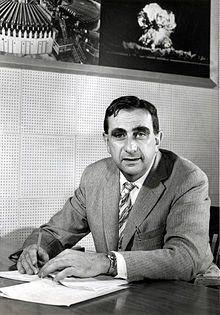Edward Teller
| Edward Teller | |
|---|---|

Teller in 1958 as Director of the Lawrence Livermore National Laboratory.
|
|
| Born |
January 15, 1908 Budapest, Austria-Hungary |
| Died | September 9, 2003 (aged 95) Stanford, California, United States |
| Residence | United States |
| Nationality |
|
| Fields | Physics (theoretical) |
| Institutions | |
| Alma mater | |
| Doctoral advisor | Werner Heisenberg |
| Doctoral students | |
| Other notable students | Jack Steinberger |
| Known for | |
| Notable awards |
|
| Spouse |
|
| Children | Paul Teller & Wendy Teller |
| Signature | |
Edward Teller (Hungarian: Teller Ede; January 15, 1908 – September 9, 2003) was a Hungarian-American theoretical physicist who was born in Hungary, and is known colloquially as "the father of the hydrogen bomb", although he claimed he did not care for the title. He made numerous contributions to nuclear and molecular physics, spectroscopy (in particular, the Jahn–Teller and Renner–Teller effects) and surface physics. His extension of Enrico Fermi's theory of beta decay, in the form of Gamow–Teller transitions, provided an important stepping stone in its application, while the Jahn–Teller effect and the Brunauer–Emmett–Teller (BET) theory have retained their original formulation and are still mainstays in physics and chemistry. Teller also made contributions to Thomas–Fermi theory, the precursor of density functional theory, a standard modern tool in the quantum mechanical treatment of complex molecules. In 1953, along with Nicholas Metropolis, Arianna Rosenbluth, Marshall Rosenbluth, and Augusta Teller, Teller co-authored a paper which is a standard starting point for the applications of the Monte Carlo method to statistical mechanics.
...
Wikipedia
